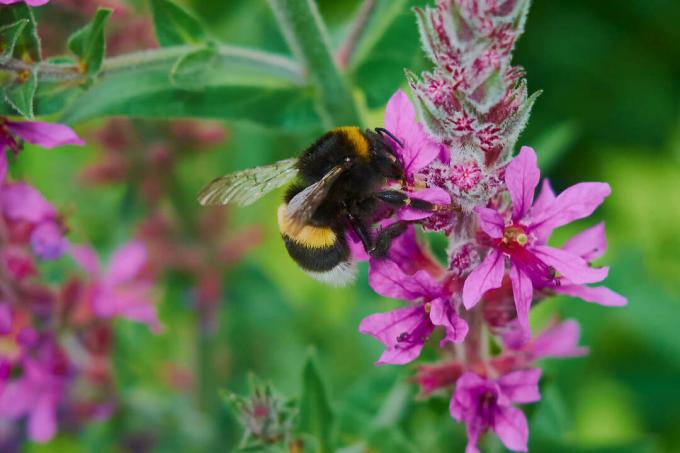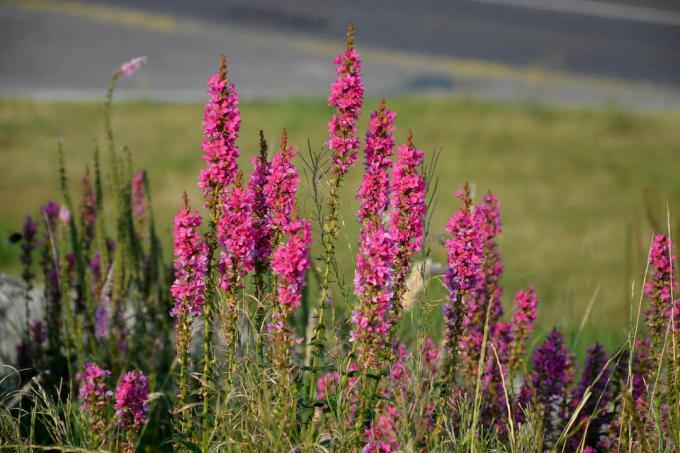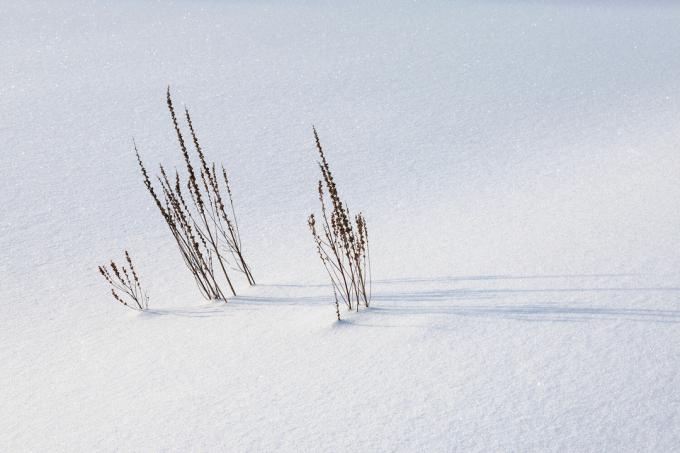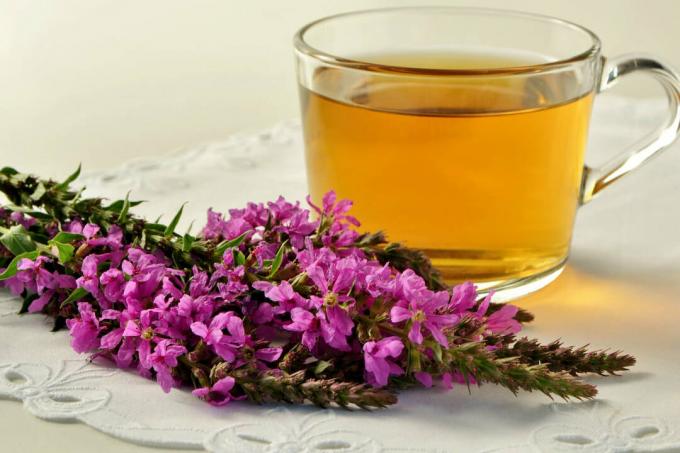The purple loosestrife makes every pond bank an eye-catcher. In contrast to many other plants, waterlogging does not bother it at all. But the adaptable purple loosestrife also feels at home in other places in the garden.

Purple loosestrife (Lythrum salicaria). The decorative flowers attract insects and, like the roots, are said to help with various ailments. Here you can find out how you can take care of this special plant in your garden.
contents
- Loosestrife: flowering time, properties and origin
- The most beautiful types and varieties
- Plant loosestrife: location and sowing
- The right care of purple loosestrife: Cutting and Co.
- Is purple loosestrife hardy?
- breed purple loosestrife
- effect and use
- Is purple loosestrife poisonous?
Loosestrife: flowering time, properties and origin
The common loosestrife (Lythrum salicaria) is a popular ornamental plant that was also used in medicine in the past. The genus of loosestrife (
Lythrum) from the loosestrife family (Lythraceae) comprises about 35 species. The loosestrife is one of the perennial, herbaceous representatives of the genus and becomes lignified over time. The perennial can reach a height of up to two meters. In its natural range in Europe and Asia, it is usually found in damp places. Parts of its shoots can even grow in water. The lanceolate purple loosestrife leaves are arranged in threes in a whorl. From June to September the purple loosestrife shows its purple splendor during the flowering period. The flowers are in racemose or spiked inflorescences on the shoots. Another species known to us for the garden is the rod loosestrife (Lythrum virgatum). Its flowers look very similar to those of the common purple loosestrife. However, they sit at the end of the up to one meter high, bare shoots.
Is purple loosestrife bee friendly? Yes, the purple loosestrife is visited by bees, but also by hoverflies, bumblebees and butterflies and offers plenty of nectar.
The most beautiful types and varieties
There are many varieties of purple loosestrife in different colors and sizes. Another type of loosestrife, the rod loosestrife, is also known as an ornamental plant.
purple loosestrife (Lythrum salicaria)
- Lythrum salicaria 'Robert': With a height of 60 – 80 cm, this purple loosestrife variety remains rather small and compact.
- Lythrum salicaria 'blush': This variety is also not large at about 70 cm and impresses with its flowers in a light pink.

- Lythrum salicaria 'Robin': This strain has purplish-pink flowers and grows compactly to a height of 80 cm.
- Lythrum salicaria 'fire candle': This purple loosestrife can even reach 1.20 m in height and has pink flowers.
Rod loosestrife (Lythrum virgatum)
- Lythrum virgatum 'Dropmore Purple': The purple loosestrife 'Dropmore Purple' makes purple, stately flowers and grows to about 80 cm tall.
- Lythrum virgatum 'Swirl': The 'Swirl' variety impresses with pink flowers and a loose inflorescence. It grows about 70 cm high.

Plant loosestrife: location and sowing
As long as the soil is sufficiently moist, the purple loosestrife can stand in one spot in the sun. If you have a garden pond, the best place to plant purple loosestrife is on the edge of the pond. There it can even grow in the shallow water zone up to 10 cm deep in the water. The robust plant also tolerates garden soil with less moisture, but it should then be in partial shade. However, flowering is also more sparse in the shade. To keep the soil moist longer, you can plant loosestrife in a pot in the garden soil. If the container only has a few drainage holes, less water can drain off and the perennial is easier to keep moist. It is best to fill the pot with a well water-storing substrate, such as ours Plantura organic universal soil. It consists of natural raw materials and the nutrient supply provides the purple loosestrife with all the important nutrients after planting. From spring to autumn you can plant the loosestrife in small groups of a maximum of ten specimens - this is how the perennial comes into its own. Keep a distance of about 50 cm to other plants.
Tip: Due to its water-purifying effect, purple loosestrife is also often used in the cleaning zone of swimming ponds.
Loosestrife in the bucket: It is also possible to keep purple loosestrife in a bucket. This should be large enough for the root ball to have enough space. If you place the pot on a saucer filled with water, the loosestrife can take care of itself and you can always see immediately when the water supply is running low.

The right care of purple loosestrife: Cutting and Co.
The robust purple loosestrife is very easy to care for. Nutrients should be supplied from time to time and the soil should always be slightly moist.
Always water enough to moisten or even wet the soil. The purple loosestrife does not like dryness at all. If he stands by the pond, it hardly needs to be watered. With potted plants, there should always be water in the saucer.

In order to ensure a good supply of nutrients, the purple loosestrife should be supplied with a long-term fertilizer once in the spring. A fertilizer with a high organic content, such as ours, is suitable for this Plantura organic universal fertilizer. It takes care of the plant for three months and only has to be used once for loosestrife. It consists largely of organic ingredients and only needs to be lightly incorporated into the soil. Alternatively, if you have compost, you can add two liters of it to the soil when planting loosestrife.
You should cut the purple loosestrife so that it can sprout nicely again. A pruning is possible both in autumn and in spring.
Cutting back after flowering in autumn primarily prevents self-seeding and the uncontrolled spread of loosestrife. To do this, cut off the shoots at the base just above the ground. This removes the inflorescences and fruit and seed formation is no longer possible.
If you refrain from pruning in autumn, you can still enjoy the beautiful discoloration of the purple loosestrife leaves. In this case, the purple loosestrife should be cut back in the following spring so that it can sprout vigorously again.
Is purple loosestrife hardy?
The purple loosestrife is hardy and can withstand temperatures down to – 40 °C. In cold winters, potted plants should be wrapped in fleece so that the substrate does not freeze through and the pot does not explode.
breed purple loosestrife
There are two ways to propagate purple loosestrife. The plant produces many seeds and is very prolific itself. If it is not cut back after flowering, there will probably be a few more specimens in the area soon. Purple loosestrife is not propagated by seed, but you can collect the seeds and apply them yourself to the desired location. Sowing takes place in spring and the seeds should be kept at a temperature of around 15°C.

Cuttings can also be cut for varietal propagation. For this purpose, a young shoot is cut off in the spring, the parts of which can be distributed over several pots. Alternatively, several cuttings can be separated from the shoot tips. Stick them in pots of potting soil up to the leaves and keep them warm and moist. Special growing soils such as ours Plantura Organic Herb & Seed Soil contain fewer nutrients so that the roots of the small plants develop splendidly. Our soil is peat-free and approved for organic farming. When new leaves form, the cuttings have formed roots and can be planted first in nutrient-rich soil and then in the bed.
Purple loosestrife can also be propagated in spring by dividing the root ball. For this, the plant must first be dug up.

effect and use
Loosestrife contains, among other things, tannins and essential oils, which also makes it interesting for medicine. The roots are mainly used, dried and boiled as loosestrife tea, as well as the flowers. The tannins have a diuretic and styptic effect. Loosestrife is also said to help with inflammation, diarrhea or infectious diseases. The native wild perennial also provides food for bees and other insects and can also be used as a cut flower.
Is purple loosestrife poisonous?
Purple loosestrife is not poisonous to humans or animals. It can be planted in the garden without hesitation and is even said to have healing effects.
the eyebright (Euphrasia officinalis) also belongs to the domestic medicinal plants. With us you will learn everything about the occurrence, cultivation and healing effects of eyebright.



